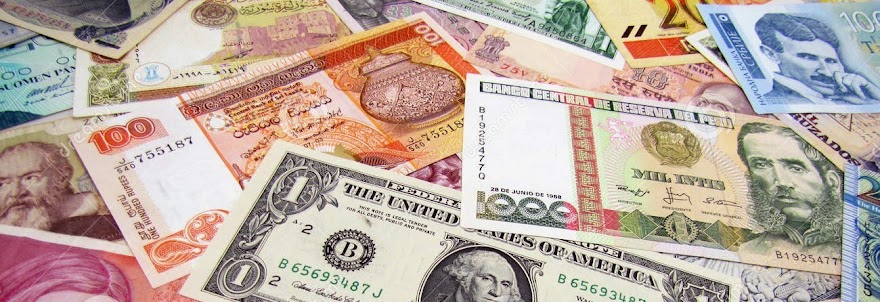The evolution of Indian Paper Money since 1810 A.D.
The actual use of the earliest banknotes is recorded in 1810, in the Bengal Presidency by Bank of Bengal. Bank of Bengal was established as 'Bank of Calcutta' in 1806 in Calcutta (Kolkata) and later the name changed into Bank of Bengal in 1809. The earliest banknotes were printed from one side only and are recognized as, Uniface Series. An example of Uniface series banknote with year of issue 1813 is shown below (n.1):
n.1, A 250 Sicca Rupees banknote issued by Bank of Bengal in 1813.
The only identified signatory in the uniface series is known: Henry Tyler. 1820s shows the change of the design of banknotes, by which they started printing on both sides. The new series are called, 'Commerce Series'. The vignette used to depict the 'Commerce' was a personified royal lady with a deceptor sitting on the articles of merchandise. A 100 Sicca Rupees note issued in 1825 is shown below with new design (n.2):
n.2, Obverse and Reverse of the Commerce Series note issued in 1825. Denomination: 100 Sicca Rupees
These banknotes of were either printed by Perkins & Heath Co. London or Perkins & Bacon Co. London. The bank often after making payments use to cut and cancel the notes as it is obvious from the above image. There also some variations in the Commerce Series, classified by the catalogue as different sub types. Some type notes are depicted below (n.3):
n.3, Type 4, Type 6, Type 9
The early signatories on the notes were; Henry Tyler (Uniface series), H. Henderson (Commerce Series), H.I. Lee (Commerce Series), J.A. Dorin (Commerce series), G.W. Moultrie (Type 9). The currency names were also changed from Sicca Rupees to Company's Rupees from 1835. Later in 1857 currency notes with name 'Rupees' were printed by banks. A 10 Rupees banknote of Bank of Bengal issued in 1857 is depicted below (n.4) is referred as; Britannia Issue:
n.4, 1857, Bank of Bengal, 10 Rupees banknote
In Bombay Presidency Bank of Bombay was established in 1848 and they started issuing banknotes between 1850 to 1860. This period of 10 years records four types according to the design. To find the Bank of Bombay banknote is tedious task today for collectors. The estimated existence is less than 100 for all types. The survived numbers of note available for collection is even lass than 10 in most of the cases. Please note the last issue of Bank of Bombay had prefix A in the serial number. The 10 Rupees banknote issued in 1860 is shown below is extremely rare example (n.5):
n.5, 1st Nov. 1860, Bank of Bombay, 10 Rupees banknote
Bank of Madras also issued its banknotes between 1850 to 1856 (Not Known accurately). In 1861 a new currency act was passed which transferred the currency issues power of these banks to the central note issuing body: Government of India. The early notes issued on or after 1861 had, portrait of Queen Victoria, and were uniface series. Later the notes with green underprint and red underprint were issued till 1920. A red underprint banknote issued in 1919 is depicted below (n.6):
n.6, 4 Oct. 1919, 10 Rupees banknote issued in 1919
The portrait notes of British Monarchs; King George V, King George VI were issued between 1917 to 1947. The first one rupee note were issue in 1917 (n.7), and later in 1935 (n.8):
n.7, 1917 1 Rupee King George V portrait note
n.8, 1 Rupee notes issued in 1935
It is also noted that, some one rupee notes were printed with Y prefix to be used in South Africa (n.9):
n.9, Notes issued in 1917 with Y-prefix, signed by AC McWatters
The higher denomination notes such as, Rs. 5, Rs. 10, were also issued with King George V portrait (n.10):
n.10, King George V portrait notes
In 1935 Reserve Bank of India Act was passed and currency notes with denominations: Rs. 2, Rs. 10, Rs. 100, Rs. 1000 and Rs. 10,000 were issued in 1937. The first signatory on the notes: J.B. Taylor (n.11):
n.11, First issue of Rs. 2 signed by JB Taylor and second issue of Rs. 5 signed by Sir C.D. Deshmukh
Higher denomination notes were issued by issuing office's name on the note. For example, below are examples of the 100 Rupees notes with Madras and Bombay overprints (n.12):
n.12, Banknotes issued by Madras and Bombay circle
The portrait on the notes changed from 1944. The new series depicted front profile of the King George VI (n.13):
n.13, Rs. 5 RBI banknote with front facing profile of King George VI issued in 1944.
Meanwhile new designs of one rupee notes with the year of issue 1940 were also printed (n.14):
n.14, 1940 1 Rupee note signed by C.E. Jones with inset A
In 1947 India hailed freedom from the British rule and the portrait notes of British Kings were changed to our national emblem 'Ashoka Pillar' (n.15):
n.15, 1950 B RamaRao 100 Rupees with only english in the denomination panel
The use of "Ashoka Pillar' on the currency notes remained till 1996. This feature is now changed to 'MK Gandhi' portrait series. RBI also stopped and demonetized higher denominations notes like; Rs. 1000, Rs. 5000 and Rs. 10,000. A 1975 1000 Rupees banknote can be seen below (n.16):
n.16, 1975 Rs. 1000 banknote issued by RBI and signed by NC Sengupta
Note: Please ask before using any image, if found doing so will attract legal obligations. These notes belong from my private collection and are not for sale. If you desire buying any one let me know, I will try getting you another one. Please visit us at: www.priceless-collectables.com or email us at: ceo@priceless-collectables.com for more information how to get rare banknotes of India.




























4!pd28w~~60_12.jpg)





